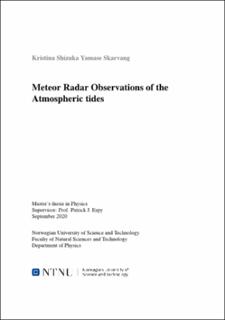Meteor Radar Observations of the Atmospheric Tides
Master thesis
Permanent lenke
https://hdl.handle.net/11250/2785566Utgivelsesdato
2020Metadata
Vis full innførselSamlinger
- Institutt for fysikk [2686]
Sammendrag
Denne oppgaven undersøker muligheten for interhemisfærisk kobling av atmosfæriske bølger under "Sudden stratospheric warming" (SSW) hendelser. Meteor-radar lokalisert ved Rothera (68S, 68W) på Antarktishalvøya har blitt brukt til å måle vinden fra 82 km til 98 km høyde, og dataene dekker datoene fra og med februar 2005 til og med august 2019 med en tidsoppløsning på 1 time og en høydeoppløsning på 2 km. Kurvetilpasning ble utført for å finne de enkelte komponentene i atmosfæriske luftbølger. Videre ble klimatologien til todagers planetære bølger, døgnbølger, halvdøgnbølger, åttetimersbølger, og gjennomsnittlig bakgrunnsvind analysert. Deretter ble "Superposed epoch analysis" (SPE) utført rundt starten av SSW-hendelsene for å undersøke om det finnes noen respons ved Rothera. Data fra dette prosjektet viste en negativ respons i halvdøgnbølger og en positiv respons i todagers planetære bølger etter SSW. Den samme analysemetoden ble brukt til å analysere responsen i atmosfæren, på magnetiske stormer, ved Rothera. Det var noe antydning til positiv respons etter stormene i døgn- og halvdøgnvinden; største avvik var imidlertid kun rundt 2 sigma. This thesis investigates the possibility of interhemispheric coupling of atmospheric waves during Sudden stratospheric warming (SSW) event. Meteor Radar located at Rothera (68S, 68W) on the Antarctic Peninsula has been used to measure the wind from 82km to 98km altitude, and the data covers data from February 2005 to August 2019 with a spectra resolution of 1 hour and an altitude resolution of 2km. Curve fitting was performed to find the individual components of atmospheric tides, and the climatology of 2-days planetary waves, diurnal waves, semidiurnal waves, terdiurnal waves, and the mean background wind were analysed. Then, superposed epoch analysis (SPE) was performed around the SSW onset to investigate whether there is a reaction. Data from this project showed a negative response in the semidiurnal tide after the SSW onset and an enhancement in the 2-days planetary waves after the SSW onset. The same analytical method was used to analyse the response in the atmosphere at Rothera to magnetic storms. There was some hint of post-storm enhancement in the diurnal and semidiurnal wind; however, the maximum enhancement was around 2 sigma.
